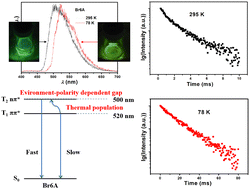Polarity-induced dual room-temperature phosphorescence involving the T2 states of pure organic phosphors†
Abstract
Emissions from higher excited states are of theoretical and experimental interest but rare. A series of pure organic phosphors, 2,5-dihexyloxy-4-bromobenzaldehyde (Br6A) derivatives, show intriguing dual-phosphorescence characteristics. Their phosphorescence emissions are blue-shifted by 20 nm at room temperature compared to those at 78 K. These shifts are accompanied by increasing contributions from a fast-decaying component. The mechanism responsible for the emission shifts observed for Br6A was studied in a 2,5-dihexyloxy-4-bromobenzene (Br6) solid matrix and solvents of various polarities. While the decay curve for Br6A in the Br6 matrix showed a single slow process, pure Br6A exhibited an additional faster decay. We demonstrated that the faster decay of pure Br6A arises from the T2 state, while Br6A in the Br6 matrix emits solely from T1. Compared to the T1 state (π, π*), the n, π* character of the T2 state ensures more efficient spin–orbit coupling with the ground state, which facilitates faster decay. The larger polarity of Br6A compared to that of Br6 leads to a lower T2 level and a smaller T2–T1 energy gap in pure Br6A, but not when in the Br6 solid matrix, which enables a T1 to T2 thermal population shift in pure Br6A at room temperature. Consistently, the emissions from the Br6A solutions gradually red-shifted with increasing solvent polarity at 78 K. Moreover, the decay curves of Br6A in solvents of low polarity were single-exponential unlike the double-exponential ones observed in polar solvents. These results provide insight into the effect of the environment on the dual phosphorescence emissions of pure organic phosphors.



 Please wait while we load your content...
Please wait while we load your content...
